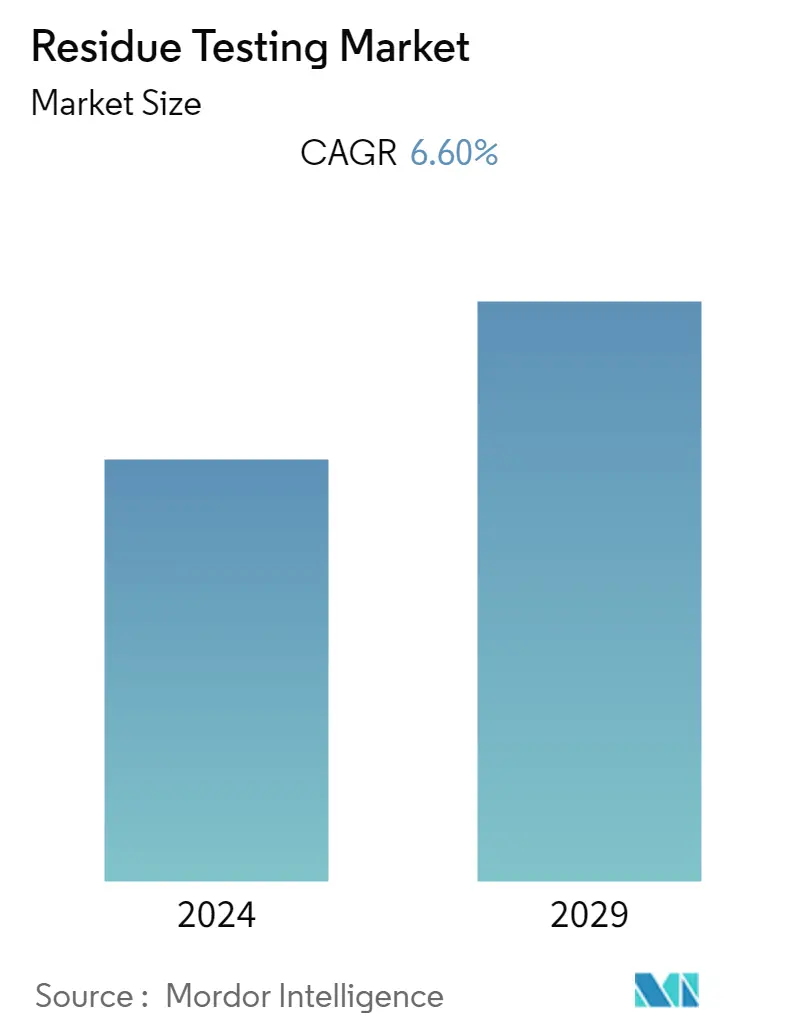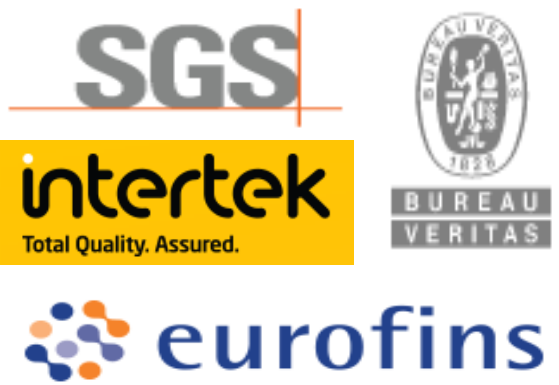Market Size of Residue Testing Industry

| Study Period | 2019 - 2029 |
| Base Year For Estimation | 2023 |
| CAGR | 6.60 % |
| Fastest Growing Market | Asia Pacific |
| Largest Market | North America |
| Market Concentration | Low |
Major Players
*Disclaimer: Major Players sorted in no particular order |
Residue Testing Market Analysis
The global residue testing market is projected to grow with a CAGR of 6.6% during the forecast period (2019-2024).
-
The residue testing market is driven by heightened consumer awareness regarding the safety aspects of food products.
-
The higher budgetary allocation for the areas concerning food safety and security have also provided major boost to the growth of the market.
-
Processed foods are the major category of products that are increasingly tested for safety and quality profiles. Based on the regional analysis, North America is a dominating region, in residue testing market closely followed by Europe.
- The global marketplace has a prominent presence of key players, however the local players are abundant, and thus, the market has a fragmented character.
Residue Testing Industry Segmentation
The global residue testing market has been segmented by product type, application, and technology. By product type, the market is sub-segmented aspesticides, heavy metals, toxins, allergens and others, and by application, it is sub-segmented as feed & pet food and food. The technology has been further categorized into HPLC-based technology, LC-MS/MC-based, immunoassay-based, and other technologies.
| Product Type | |
| Pesticides | |
| Heavy Metals | |
| Toxins | |
| Allergens | |
| Others |
| Technology | |
| HPLC-based | |
| LC-MS/MS-based | |
| Immunoassay-based | |
| Other Technologies |
| Application | |||||||
| Feed and Pet Food | |||||||
| Agricultural Crops | |||||||
|
| Geography | |||||||||
| |||||||||
| |||||||||
| |||||||||
| |||||||||
|
Residue Testing Market Size Summary
The residue testing market is experiencing significant growth, driven by increasing consumer awareness about food safety and the need for stringent quality assurance in food products. This heightened awareness has led to a greater emphasis on testing processed foods to ensure they meet safety and quality standards. The market is further bolstered by increased budget allocations for food safety and security, which have provided a substantial boost to its expansion. North America leads the market, followed closely by Europe, with both regions benefiting from advanced surveillance and detection methods. The presence of key players alongside numerous local entities contributes to the market's fragmented nature, with companies employing strategies such as mergers, acquisitions, and expansions to enhance their market presence and diversify their offerings.
The global residue testing market is also shaped by the rising incidence of foodborne illnesses and contamination cases, which underscore the critical importance of food safety. Stringent regulations, such as the zero tolerance policy for Listeria contamination, are driving the demand for residue testing, particularly in North America, where the Food Safety Modernization Act has significantly impacted the food industry. Consumer demand for transparency and safety in food products is prompting technological advancements and the adoption of innovative testing methods, such as DNA bar code tests for species identification. Major players in the market, including SGS S.A., Bureau Veritas S.A., and Eurofins Scientific, are actively pursuing strategic initiatives like mergers and acquisitions to strengthen their market position and expand their service offerings.
Residue Testing Market Size - Table of Contents
-
1. MARKET DYNAMICS
-
1.1 Market Drivers
-
1.2 Market Restraints
-
1.3 Porters Five Forces Analysis
-
1.3.1 Threat of New Entrants
-
1.3.2 Bargaining Power of Buyers/Consumers
-
1.3.3 Bargaining Power of Suppliers
-
1.3.4 Threat of Substitute Products
-
1.3.5 Intensity of Competitive Rivalry
-
-
-
2. MARKET SEGMENTATION
-
2.1 Product Type
-
2.1.1 Pesticides
-
2.1.2 Heavy Metals
-
2.1.3 Toxins
-
2.1.4 Allergens
-
2.1.5 Others
-
-
2.2 Technology
-
2.2.1 HPLC-based
-
2.2.2 LC-MS/MS-based
-
2.2.3 Immunoassay-based
-
2.2.4 Other Technologies
-
-
2.3 Application
-
2.3.1 Feed and Pet Food
-
2.3.2 Agricultural Crops
-
2.3.3 Food
-
2.3.3.1 Meat and Poultry
-
2.3.3.2 Dairy
-
2.3.3.3 Fruits and Vegetables
-
2.3.3.4 Processed Food
-
2.3.3.5 Other Foods
-
-
-
2.4 Geography
-
2.4.1 North America
-
2.4.1.1 United States
-
2.4.1.2 Canada
-
2.4.1.3 Mexico
-
2.4.1.4 Rest of North America
-
-
2.4.2 Europe
-
2.4.2.1 Germany
-
2.4.2.2 United Kingdom
-
2.4.2.3 France
-
2.4.2.4 Italy
-
2.4.2.5 Russia
-
2.4.2.6 Spain
-
2.4.2.7 Rest of Europe
-
-
2.4.3 Asia-Pacific
-
2.4.3.1 India
-
2.4.3.2 Australia
-
2.4.3.3 China
-
2.4.3.4 Japan
-
2.4.3.5 Rest of Asia-Pacific
-
-
2.4.4 South America
-
2.4.4.1 Brazil
-
2.4.4.2 Argentina
-
2.4.4.3 Rest of South America
-
-
2.4.5 Middle East & Africa
-
2.4.5.1 South Africa
-
2.4.5.2 Saudi Arabia
-
2.4.5.3 Rest of Middle East & Africa
-
-
-
Residue Testing Market Size FAQs
What is the current Residue Testing Market size?
The Residue Testing Market is projected to register a CAGR of 6.60% during the forecast period (2024-2029)
Who are the key players in Residue Testing Market?
SGS SA, Bureau Veritas, Eurofins Scientific, Intertek Group plc and AsureQuality Limited are the major companies operating in the Residue Testing Market.

